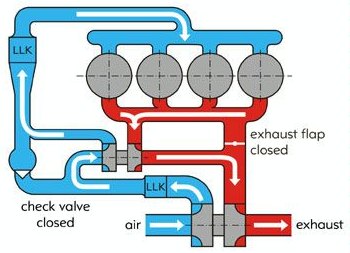- Joined
- 10 August 2010
- Messages
- 633
Hi Dave, good to hear from you and I appreciate your offer.
However, on the design I am using, the Aerocharger won't be a choke point. I have intake and exhaust valves enroute overseas from an OEM supplier in order to accomodate this arrangement:

That's why I said in my previous post that I had to make some assumptions on valve cracking dP and opening rate... and potentially why I have a big dip in mid-range torque. I won't know for sure until I fab everything up and actually test it.
I would also like to make everything as simple and passive as possible. I also have tried to make this a "fail-safe" design in case there are issues with the vain controller, exhaust valve, and intake valve sticking. One of the ways to do this was complicate it a bit more with BCSV, wastegate, etc.
Glad to hear you've had experience on compound setups - now I know who to contact first when I get ready to tune it!
Dave
Looks like a Sequential Semi Compounded setup. What is your larger turbo going to be, and what pressure ratios will you be running on each turbo?








